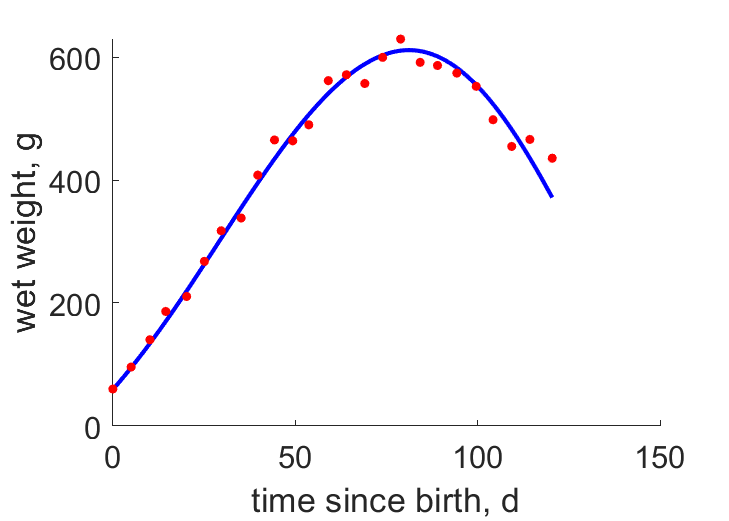Predictions & Data for this entry
| Model: std | climate: MA | migrate: | phylum: |
| COMPLETE = 2.5 | ecozone: MPE | food: biCvf, biCik, biCic | class: |
| MRE = 0.015 | habitat: 0iMc | gender: Dg | order: |
| SMSE = 0.001 | embryo: Tntfm | reprod: O | family: |
Zero-variate data
| Data | Observed | Predicted | (RE) | Unit | Description | Reference |
|---|---|---|---|---|---|---|
| ab | 55 | 55.91 | (0.01653) | d | age at birth | Warh1990 |
| tx | 120 | 120.1 | (0.0005662) | d | time since birth at fledging | Warh1990 |
| tp | 360 | 358.7 | (0.003652) | d | time since birth at puberty | guess |
| tR | 730 | 730 | ( 0) | d | time since birth at 1st brood | guess |
| am | 9125 | 9080 | (0.004921) | d | life span | guess |
| Wwb | 60 | 59 | (0.0166) | g | wet weight at birth | Warh1990 |
| Wwi | 700 | 714.4 | (0.02063) | g | ultimate wet weight | Warh1990 |
| Ri | 0.00274 | 0.002726 | (0.00514) | #/d | maximum reprod rate | Wiki |
Uni- and bivariate data
| Data | Figure | Independent variable | Dependent variable | (RE) | Reference |
|---|---|---|---|---|---|
| tW |  | time since birth | wet weight | (0.03872) | Warh1990 |
Pseudo-data at Tref = 20°C
| Data | Generalised animal | Pterodroma phaeopygia | Unit | Description |
|---|---|---|---|---|
| v | 0.02 | 0.01701 | cm/d | energy conductance |
| p_M | 18 | 499.6 | J/d.cm^3 | vol-spec som maint |
| k_J | 0.002 | 0.02148 | 1/d | maturity maint rate coefficient |
| k | 0.3 | 0.3142 | - | maintenance ratio |
| kap | 0.8 | 0.7034 | - | allocation fraction to soma |
| kap_G | 0.8 | 0.8015 | - | growth efficiency |
| kap_R | 0.95 | 0.95 | - | reproduction efficiency |
Discussion
- Feeding is reduced towards end of nestling period
- Long tp cannot be captured by std model
- Body temperature is guessed
- mod_1: Pseudo-data point k is used, rather than k_J; Data set tp and parameter t_R are added, the latter replacing clutch interval t_N. Postnatal T is based on PrinPres1991, see get_T_Aves. See further the revision page, theme puberty
Bibliography